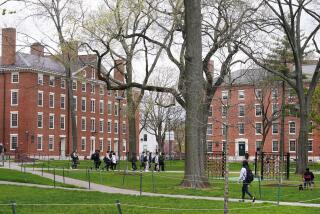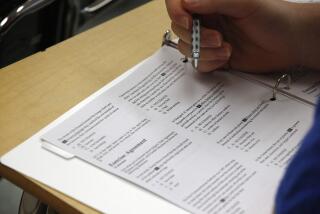Colleges Begin to Ask If Students Get Their Money’s Worth
- Share via
WILLIAMSBURG, Va. — In one of the many red-brick buildings at the stately College of William and Mary there’s an evidence room.
Here professors deposit proof that their courses deliver on the school’s promise of a broad liberal arts education.
Large yellow envelopes arrive stuffed with student essays and exams, syllabuses, texts, even a physics homework kit: silky copper wire, D-cell battery, toy motors and dime-size compass that students use to build gizmos in a course called “How Things Work.”
All will be examined, discussed, rated and checked against student satisfaction surveys. And it’s only part of the school’s continuous self-examination to ensure its 7,560 students learn what they came for. The latest buzz in higher education is “outcomes assessment,” and William and Mary has been at it full tilt for four years.
Soon, propelled by a little-noted act of Congress, every accredited college and university in the country will need to show that its students are actually learning.
Once, colleges were satisfied to admit good prospects, usher them through a battery of courses and offer best wishes on graduation day. The public was satisfied too.
“For a long time ‘Trust us’ worked,” said Judith Eaton, head of the Council for Higher Education Accreditation in Washington.
Not anymore.
Not even at places like William and Mary, a renowned public university with an Ivy League soul. The highly selective school’s 1693 founding makes it America’s second-oldest university, after Harvard (1636). Thomas Jefferson studied here.
Now, in a process that has evolved since the mid-1980s and is invisible to students, William and Mary faculty at all levels check the substance of courses against a host of criteria.
The purpose is not to appraise teachers or students, but solely to discover “whether general education is doing what it’s intended to do,” said Susan Lovegren Bosworth, assessment director.
For instance, each core science course is judged on a 0-5 scale for such elements as “the development and testing of scientific theories” and “the historical development of science.”
A scoring sheet for student writing samples includes “rational, logical development,” “appropriate tone, mood” and “carefully proofread and edited.”
For majors like sociology or physics, evaluations get more complex, looking at not only curricula but advising, writing requirements, library holdings and enrollment.
Alumni can expect to be surveyed regularly on how well their William and Mary education served them--or not.
David Epstein chose William and Mary four years ago based on dazzling guidebook accounts and its exalted spot in popular rankings. But how could a teenager from East Windsor, N.J., tell the school was all it was cracked up to be? Even a visit could not assure that.
“The closest you’re going to get is . . . the student-teacher ratio, your guide telling you professors are very approachable,” recalled Epstein, a senior who is set to graduate with a degree in government.
In coming years, however, the school’s self-evaluations will be available to prospective students along with the rest of the public, Bosworth said.
The national move for more accountability in higher education began in the mid-1980s. Employers complained that recent graduates couldn’t write coherently, or even spell. Yet college costs were soaring.
State and federal governments demanded to know if taxes--and family dollars--were well spent. Congress pushed accrediting agencies to look at student learning.
This intensified in the 1990s with the growth of distance learning and questions it raised about the validity of college online.
When Congress reauthorized the Higher Education Act in 1998, first among its requirements for accrediting agencies is that they address “success . . . in student achievement in relation to the institution’s mission.” Some interpreted this as giving outcomes assessment top priority.
Although accrediting is voluntary, any private or public college seeking federal money, including student loans, must be accredited by an agency recognized by the U.S. government.
The various accrediting bodies evaluate schools periodically, generally every five to 10 years, and will expect them to implement some form of outcomes assessment.
A number of institutions--no one is sure how many--have evaluation systems in place due to farsighted leaders, legislative pressure or, in the case of William and Mary, a mandate from Virginia’s state body overseeing public colleges and universities.
William and Mary faculty were wary of measuring outcomes, said David Aday, head of American Studies and chairman of the assessment steering committee. But professors were persuaded to take charge of the process.
“If we’re not out in front leading it,” Aday said, “it could be a very top-down, corporate kind of process, where we transform from education people to making widgets.”
Instead, William and Mary’s self-assessment has started an ongoing conversation about teaching. Professors organize courses better, making the purpose clear, rather than leaving students to guess what the teacher is up to.
“One of the real values of higher education is that you learn how to learn,” Aday said. “This is good for a lifetime.”
The worry for skeptics in all this evaluation is seeking any yardstick for a process as subtle and complex as learning, as if college were a production line. They raise the specter of “one-size-fits-all” curricula, “exit tests” to graduate, and ranking schools based on outcomes.
Martin Trow at UC Berkeley endorses self-examination but is a vocal critic of attempts to quantify the results.
“It’s a terrible idea,” said Trow, a professor emeritus in public policy. The true aim of higher education, he said, is to give students “an idea of how to think and how to argue, and try to cultivate people’s sensibilities.”
The ability to think and judge, Trow said, “doesn’t really lend itself to these sort of metrics.”
Self-evaluation is also hard. Schools typically spend years identifying outcomes and agreeing how to measure them. Unlike public grade schools, colleges and universities vary enormously in purpose, the kinds of students they serve and financial resources.
For that reason, the particulars of assessment will largely be left to each of the nation’s 4,000 two- and four-year institutions.
Still, experts say, higher education will never be the same once self-assessment is widespread. The interplay of teaching and learning will become the focus, not just grades or graduation rates.
Peter Ewell, a leading outcomes expert at the National Center for Higher Education Management Systems in Boulder, Colo., said the results of these evaluations will eventually work their way into the courses colleges offer.
“It’s going to be more and more and more embedded in the curriculum,” he said.
*
College of William and Mary:
https://www.wm.edu
More to Read
Sign up for Essential California
The most important California stories and recommendations in your inbox every morning.
You may occasionally receive promotional content from the Los Angeles Times.













